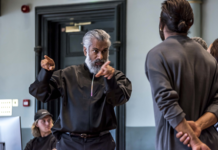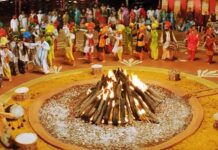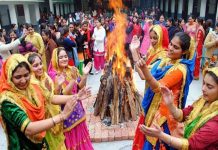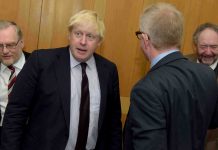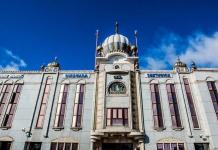Destroying Islamic Heritage
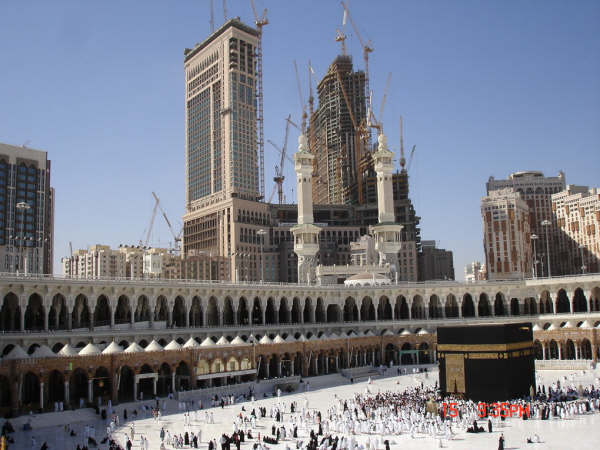 The Arabian Peninsula, the cradle of Islam, is being demolished by hardliners. In countries such as Saudi Arabia almost all of the Islamic historical sites are gone, but this is not the first time they have been destroyed.
The Arabian Peninsula, the cradle of Islam, is being demolished by hardliners. In countries such as Saudi Arabia almost all of the Islamic historical sites are gone, but this is not the first time they have been destroyed.
In 1802, and army led by the sons of Muhammad ibn ‘Abd al-Wahhab (the founder of Wahhabism) and Muhammad ibn Saud occupied Taif and began a bloody massacre. A year later, the forces occupied the holy city of Mecca. They executed a campaign of destruction in many sacred places and leveled all the existing domes, even those built over the well of Zamzam. However, after the army left, Sharif Ghalib breached the truce, inciting the Wahhabis to re-occupy Mecca in 1805.
In 1806, the Wahhabi army occupied Medina. They did not leave any religious building, including mosques, without demolishing it, whether inside or outside the Baqi’ (graveyard). They intended to demolish the grave of the Prophet Muhammad, may the peace and blessings of God be upon him, many times, but would repeatedly change their minds. At this time, non-Wahhabi Muslims were prevented from performing the Hajj (pilgrimage). In 1805, Iraqi and Iranian Muslims were refused permission to perform Hajj, as were the Syrians in 1806 and Egyptians the following year. The Saudi leader at the time wanted the pilgrims to embrace his Wahhabi beliefs and accept his Wahhabi mission. If they refused, he denied them permission to perform the Hajj and considered them heretics and infidels—ignoring the word of God in Sura al-Baqara:
And who is more unjust than he who forbids that in places for the worship of God, His name should be celebrated? Whose zeal is (in fact) to ruin them? It was not fitting that such should themselves enter them except in fear. For them there is nothing but disgrace in this world, and the world to come, an exceeding torment. (Qur’an 2:114)
The Wahhabi army’s destruction campaign targeted the graves of the martyrs of Uhud, the mosque at the grave of Sayyid al-Shuhada’ Hamza bin Abdul Muttalib and the mosques outside the Baqi’: the Mosque of Fatima al-Zahra, the Mosque of al-Manaratain, and Qubbat’ al-Thanaya (the burial site of the Prophet’s incisor that was broken in the battle of Uhud). The structures in the Baqi’ were also leveled to the ground and not a single dome was left standing. This great place that was visited by millions of Muslims over many centuries became a garbage dump, such that it was not possible to recognise any grave or know whom it embraced.
The occupation of the holy places by the army and their preventing Muslims from performing Hajj led thousands of people to flee Mecca and Medina to escape religious persecution. The Muslims started to complain and express their concerns, and public opinion put pressure on the Ottoman Caliph to liberate and rebuild the two holy places and once again permit the Muslims to perform the pilgrimage. Accordingly, an army led by Muhammad Ali Pasha, the Caliph’s viceroy in Egypt, was sent. When the forces arrived in the Hijaz, a number of tribes marched in support of the army, which regained control over Medina and then Mecca.
In 1818, the Wahhabis were defeated and they withdrew from the holy places. The Prophet’s Mosque, the Baqi’ and the monuments at Uhud were rebuilt during the reigns of the Ottoman sultans ‘Abd al-Majid I, ‘Abd al-Hamid II and Mahmud II. From 1848 to 1860, the buildings were renovated and the Ottomans built the domes and mosques in splendid aesthetic style. They also rebuilt the Baqi’ with a large dome over the graves of the Prophet’s daughter Fatima al-Zahra, Imam Zainul ‘Abidin (‘Ali bin al-Hussain), Imam Muhammad ibn ‘Ali al-Baqir and Imam Ja‘far al-Sadiq. The graves of others related to the Prophet found at the Baqi’ include those belonging to Ibrahim (son), ‘Uthman ibn ‘Affan (Companion and son-in-law), Saffia bint Abdul Muttalib (aunt), Atika bint ‘Abd al-Muttalib (aunt), Al-‘Abbas ibn ‘Abd al-Muttalib (uncle), Fatima bint Assad (Imam Ali’s mother), ‘Abd Allah ibn Ja‘far bin Abi Talib (cousin) and Aqil ibn Abi Talib (The Prophet’s cousin).
The grave of the Prophet’s father ‘Abd Allah was in Dar al-Nabigha of the Bani Najjar, the house of where the Prophet learned to swim. However, his father’s grave was exhumed 17 years ago and transferred to the Baqi’. The area of the house today lies under the marble covering the plaza surrounding the mosque.
A number of the Prophet’s wives (the Mothers of the Faithful) were buried in the Baqi’: ‘A’isha, Hafsa, Juwayriya, Saffia, Sawda, Zaynab bint Khuzaima, Zaynab bint Jahsh, Umm Habiba and Umm Salama. The tomb of Khadija, the Prophet’s first wife, is in Mecca because she died before the Hijra (migration of Muslims to Medina). Her grave is in the Hajun cemetery, known as Maqbarat’al-Ma’la. The tomb of Maimouna, another wife, is also in Mecca in an area known as Sarif, which lies on the side of the Hijra Road, nearly 13 miles (20 kilometers) outside Mecca.
On April 21,1925, the domes in the Baqi’ were demolished once more along with the tombs of the holy personalities in Maqbarat’al-Ma‘la in Mecca, where the Holy Prophet’s mother, wife Khadija, grandfather and other ancestors are buried. Destruction of the sacred sites in the Hijaz continues till this day. Wahhabis say they are trying to rescue Islam from what they consider innovations, deviances and idolatries. Among the practices they believe are contrary to Islam are constructing elaborate monuments over graves and making supplications there.
The Mashrubat Umm Ibrahim—which was built to mark the location of the house where the Prophet’s son, Ibrahim, was born to Mariah, his Egyptian wife—also contained the grave of Hamida al-Barbariyya, the mother of Imam Musa al-Kazim. These sites were destroyed over the past few years.
I recently met with one of the leading political leaders of Medina and took the opportunity to speak to him about the destruction of these holy sites. He told me that the sites were not being demolished, but that torrential rain in Medina was washing away the old buildings! I told him the mosque and tomb of Sayyid Imam al-Uraidhi ibn Ja‘far al-Sadiq, four miles from the Prophet’s Mosque, was destroyed by dynamite and flattened on August 13, 2002. Imam al-Uraidhi is ninth in line from the Prophet. I also asked him about the plan to demolish the last remnant of the historical vestiges of the Messenger of God, namely his noble birthplace, which has been converted into a library, “Maktabat Makka al-Mukarrama.” There was no answer.
Within the last 10 years, Muqbil ibn Hadi al-Wadi’i, a student at the University of Medina, wrote a thesis titled “About the Dome Built over the Grave of the Messenger,” sponsored by Sheikh Hammad al-Ansari. In this paper, the student demands that the noble grave be brought out of the Mosque. He says the presence of the holy grave and noble dome are major innovations and that they both need to be destroyed! His thesis received very high marks. Last year, the city planning board of Medina painted the famous green dome of the Prophet’s Holy Mosque silver. After intense protests by the citizens of Medina, the board restored the dome to its original colour.
In the Ottoman part of the Prophet’s Mosque, at the centre of the three sections raised a bit from the ground level are three circles. The first, toward the west, corresponds to the grave of the Prophet. The next two toward the east correspond to the graves of Abu Bakr al-Siddiq and ‘Umar ibn al-Khattab. Above the circles are invocations including “Ya Allah” and “Ya Muhammad.” The latter was removed and replaced it with “Ya Majid” by adding the dot under the ‘ha of Muhammad to make it jim and two dots under the second mim of Muhammad to make it ‘ya. There are qasidas written by rulers of the Muslim world, such as Sultan ‘Abd al- Hamid. Many verses of the famous Burda of al-Busayri had also been painted over. On the Qibla side, the brass partition that is divided into three sections between two columns, the authorities have also tried to cover the famous two verses inscribed in the east from the story of al-‘Utbi as mentioned by Ibn Kathir in his Tafsir. “O best of those whose bones are buried in the deep earth, and from whose fragrance the depth and height have become sweet! May I be the ransom for a grave in which you dwell, where purity, bounty and munificence.”
If one raises his head a bit, he will see on the first section of this partition a green banner, on which the words of the Almighty are framed in yellow:
O you who believe! Raise not your voices above the voice of the Prophet, may blessings and peace be upon him and his family, nor speak aloud to him in talk, as you speak aloud to one another, lest your deeds be rendered fruitless while you perceive not. (Qur’an 49:2)
The Sacred Chamber has four exterior doors: on the south, Bab al-Tawba (The Door of Repentance), on the north, Bab al-Tahajjud (The Door of Night Prayer), on the east, Bab Fatima (the Door of Fatima), and on the west, Bab al-Nabi (The Door of the Prophet)—also known as Bab al- Wufud (The Door of Delegations). These gates have been present since the year 668 AH except for the Gate of the Night Prayer, which was installed in 729 AH. Inside there are two gates, one on either side of the triangular part of the interior compartment. All of these doors are covered by brass shelves holding Qur’ans, an attempt to prevent the public from looking inside the Sacred chamber.
The Wahhabi religious authorities are, unfortunately, on a fast track. In 1998 the grave of Amina bint Wahb, the Prophet’s mother, was bulldozed in Abwa and gasoline was poured on it. Even though thousands of petitions throughout the Muslim world were sent to Saudi Arabia, nothing stopped this action. One of my late teachers, Sheikh Sayyid Muhammad ibn ‘Alawi al-Maliki, a Meccan who was a great historian on the holy sites and inherited his knowledge from his father and forefathers who were all teachers of the holy Haram, showed me pictures of the grave of Sayyida Amina marked with a pile of stones after the destruction. The House of Khadija was excavated during the Haram extensions, then hurriedly covered over so as to obliterate any trace of it. This was the house where the Prophet received some of his first revelations and it is also where his children Umm Kulthum, Ruqqaya, Zaynab, Fatima, and Qasim were born. Dar al-Arqam, the first school in Islam where the Prophet taught has also been demolished. It was in the area of Shi’b ‘Ali near the Bab ‘Ali door opposite the king’s palace. It is now part of the extension of the Haram.
The authorities plan to demolish the house of Mawlid, where the Prophet was born. About 60 years ago, this house, which used to have a dome over it, was turned into a cattle market. Some people then worked together to transform it into a library, which it is today. It is lined with shelves of books about Mecca, most of them written by Meccans. But the library is under threat again because of the new Jabal ‘Umar project, one of the largest real estate development projects near the Grand Mosque. The birthplace of the Prophet is to make way for a car park and hotels. About 99% of real estate owners in the Jabal ‘Umar area are shareholders in this company. The owners have been provided with financial incentives, including what they used to receive as rents, combining five-star facilities under the luxurious Le Meridien banner. The Meridien Towers will allow several thousand housing units in Mecca to be available during specified periods of time, for a one-off, fixed fee, giving the towers 25 years of shared ownership in Mecca. This scheme allow outsiders, whether Muslim or not, to invest in the city; they will be allowed to buy from a range of properties that can be used, sublet, resold or given as a gift.
Another site that was demolished is the Ottoman Fort which was built on Bulbul hill overlooking the Grand Mosque. It was built in 1780 by the ruling Ottomans to protect the city and its Muslim shrines from invaders. The 220-year-old al-Ajyad fort was demolished in 2002 to make way for a $533m project for furnished apartments. Minister of Islamic Affairs, Saleh Al-Sheikh said that ‘No-one has the right to interfere in what comes under the state’s authority’, he added that the Ajyad fort will be rebuilt by experts in the same traditional way it was first built and at the same site. This was an obvious lie as the fort was bulldozed never to be replaced again. The fort was demolished rather than dismantled, therefore how would it have been possible to rebuild it in the exact same way again? Today, the Zam Zam towers stand in place of the Fort. The Zam Zam towers are being leased from £500,000 to £1,000,000 for a 24 year lease, the prices are very extortionate as during last ten days in the holy month of Ramadan it would cost between £54,000 to £137,500 to rent plus extra annual maintenance charges. Yet another Saudi Wahhabi plot destroying Islamic heritage.
There is no new sewage system in place as the old Ottoman system is still in use near the Grand mosque. Therefore if you dig anywhere around the Grand mosque between 3 to 5 meters deep you would find sewage. The holy Cemetery of Al-Muala in Mecca where the Prophets wife and members of his household are buried is drowning in sewage and the authorities are reluctant to act. “Dead people have dignity,” Nabil Al-Hamawi, a local resident of Mecca states. “One of the things that a dead man is entitled to is a clean burial spot. We are very upset about what it happening at Al-Muala cemetery, where sewage from nearby houses leaks out. We must all work together to solve this problem and divert the water somewhere else. How can we bury the dead in a cemetery full of filth and pollution?” he asked.
“We have asked the authorities many times to solve this problem,” Sheikh Jaber Al-Madkhali, another resident said. “If they are not going to do anything, the people will have to work together to protect the dignity of the dead.”
Last Ramadan in Mecca, authorities built a wall enclosure in the Haram for women to pray there so men will not be able to see them. However, this has also blocked women’s visibility of the Ka‘ba while they perform their prayers. The tawaf (circumambulation) for women has also been restricted to certain times.
In Medina, of the seven mosques at the site of the Battle of the Trench (Jabal al-Khandaq), where Sura al-Ahzab was revealed, only two remain. The others have been demolished and a Saudi bank’s cashpoint machine has been built in the area. The remaining mosques will be demolished as soon as the new mosque being constructed is ready. One of the mosques slated for destruction is Masjid Fath, the mosque and rock of victory, where the Prophet stood during the battle of the trench praying for victory. On the rock is where he received God’s promises of victory and of the conquest of Mecca.
The Baya Mosque which is on the way to Mina is next in line for demolition as the Wahhabi Ulem’a want the vicinity of stoning the Jamarat increased all the way to where this Mosque stands today. The mosque is historically significant because it is where “The Pledge of Allegiance” at al-‘Aqaba in 2 B.H/620 C.E occurred. The first 12 Ansar (Helpers) from Madina accepted Islam and pledged their allegiance to Prophet Muhammad here. This is another Wahhabi plot to destroy yet another historical site belonging to Prophet Muhammad. The Wahhabis want to destroy the cave where Prophet Muhammad rested during the Battle of Uhud. It has become the subject of debate amongst the Wahhabi scholars, some arguing for its destruction because pilgrims have been coming to this cave in increasing numbers to seek blessings.
A local resident said that the question of what to do about the unsanctioned visits was raised more than six years ago. Anwar Bakri , professor at Tayba University in Madinah , warns against extremist movements that want to destroy all monuments in Madinah . He said that destroying the cave would only increase anger and not solve the problem and will damage the image of Islam. On the other hand Al- Jarbu, a teacher at the Madinah Islamic University where extremist Wahhabi Islam is taught, believes that destroying the site is the only solution. He said that there is no point in placing fences around the site because people will still go over the fence to the cave. “The only solution in my mind is to destroy it because there are some locals who are benefiting from it,” Al-Jarbu said. “Destroying it will solve the problem for good.”
The destruction of the historical sites is yet another way for the Wahhabi sect to show that there is no other form of Islam- whether on the ground, in the past, or in people’s memories- other than their own.
*The house of the companion, Abu Bakr is where the Mecca Hilton Hotel stands today.
*The mosque Abu-Qubais (Makka), is where the king’s palace stands today
*Dar-ar-Arqam, the first school of Islam is where the escalators are situated today.
*The birthplace of the Prophet Muhammad is a library today, and is next in line to be demolished to make way for a car park and complex.
By Dr. Al Alawi
Dr. Al Alawi is a Barrister and University lecturer and a historian on the two holy cities Joint Chairman of the Islamic Heritage Research Foundation, which was formed to help protect and preserve the holy sites in the Hijaz. For more information contact info@savethehijaz.com


